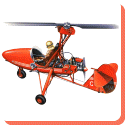 Autogiro — An autogiro is a small, quiet, reliable, rotary-winged aircraft. This Wallis autogiro cruises at about 160 km/h (100 mph), weighs about 227 kg (500 lb), and has a range of about 320 km (200 mi).
Autogiro — An autogiro is a small, quiet, reliable, rotary-winged aircraft. This Wallis autogiro cruises at about 160 km/h (100 mph), weighs about 227 kg (500 lb), and has a range of about 320 km (200 mi).
An autogyro (autogiro) is a type of rotorcraft supported in flight by lift provided by a rotor. Unlike a helicopter, the rotor of an autogyro (autogiro) is driven by aerodynamic forces alone once it is in flight, and thrust is provided by an engine-powered propeller similar to that of a fixed-wing aircraft. The autogyro is a distinct type of aircraft and not a hybrid between fixed-wing aircraft and helicopters.
The autogyro (autogiro) was invented by Juan de la Cierva y Codorniu in 1919, and it made its first successful flight on January 9, 1923 at Cuatro Vientos Airfield in Madrid, Spain.
Autogyros are also known as gyroplanes, gyrocopters, or rotaplanes. When the term is spelled autogiro it is a trademark that can only be applied to products of the Cierva Autogiro Company or its licensees, and the name Gyrocopter was a trademark of the Bensen Company.
The Cierva Autogiro Company was taken over by Saunders Roe in 1951, which in its turn became part of Westland Helicopters Ltd. in 1961; Westland is now part of AgustaWestland.
General Characteristics
Autogyros can take off and land in significantly smaller areas than fixed-wing aircraft, and, depending on the model, can operate from helipads. When fitted with a jump takeoff feature, an autogyro can take off from a standing start into forward flight, accelerate while in ground effect, and then climb.
The climb angle after takeoff is relatively shallow, similar to that of a STOL fixed-wing aircraft. Sufficient area must be available after takeoff for the autogyro to turn and avoid obstacles during climb. This limitation, as well as the lack of hovering performance, is primarily responsible for autogyros being superseded by helicopters.
Gyroplanes also cannot fly safely under low-g conditions, such as a pitch-over maneuver commonly used in fixed-wing aircraft, due to excessive loss of rotor rpm and resulting rotor instability. This is particularly a problem with Bensen-type gyroplanes due to their lack of pitch stability and use of a teetering rotor.
It is possible to land an autogyro in an area from which it cannot take off. An autogyro can easily execute a steep approach to a no-roll landing. If rotor collective pitch control is provided, an autogyro can execute a collective flare; otherwise, landings are always made with a cyclic flare.
As intended by la Cierva, the rotor always turns regardless of the airspeed of the aircraft, though as airspeed decreases rotor rpm reduces to a minimum value at zero airspeed. Autogyros cannot hover for more than a few moments at most, since the rotor is declutched from its drive before starting the takeoff procedure and its speed decays quickly. Reduction of engine power increases the descent rate, though the autogyro remains fully stable and controllable. Directional control, provided by a rudder, can become nonexistent at low airspeed and low propeller thrust. For example, the Air & Space 18A gyroplane rudder rapidly loses effectiveness below 50 mph airspeed when the engine is throttled back.
Most autogyros are neither efficient nor very fast, although Ken Wallis has achieved 120 mph from 60 bhp in one of his designs. More recently the CarterCopter achieved a speed of 170 mph. Fixed-wing aircraft are faster and use less fuel over the same distance, while helicopters generally require more power (and hence more fuel) than either fixed wing aircraft or autogyros for the same speed and load. Autogyro development ceased before World War II, and with few exceptions, has not benefited from modern rotary wing advances applied to helicopters. When improvements in helicopters made them practical, autogyros became largely neglected. They were, however, used in the 1930s by major newspapers, and by the US Postal Service for mail service between the Camden, NJ airport (USA) and the top of the post office building in downtown Philadelphia, Pennsylvania (USA).
Autogyros can be of tractor configuration (with the engine(s) and propeller(s) at the front of the fuselage), e.g., Cierva, or pusher configuration (with the engine(s) and propeller(s) at the rear of the fuselage), e.g., Bensen. Early autogyros were fitted with fixed rotor hubs, small fixed wings, and control surfaces like those of a fixed wing aircraft. These designs were problematic, because at low airspeeds, the control surfaces became ineffective and could readily lead to loss of control, particularly during landing. The direct control rotor hub, which could be tilted in any direction by the pilot, was first developed on the Cierva C.19 Mk. V and saw production on the Cierva C.30 series of 1934.
Rotor drives initially took the form of a rope wrapped around the rotor axle and then pulled by a team of men to accelerate the rotor – this was followed by a long taxi to bring the rotor up to speed sufficient for takeoff. The next innovation was a fully deflectable horizontal stabilizer that directed propeller slipstream into the rotor. Cierva {license?}, Pitcairn-Cierva Autogiro Company of Willow Grove, Pennsylvania, finally solved the problem with a light mechanical transmission driven by the engine.
The Groen Brothers Hawk 4 design of 1992 is advertised as possessing “Ultra-Short Take-Off and Landing” (USTOL) capability, enabling the aircraft to take off and land within a very short distance (25 feet). This is merely a new name for performance autogyros have always possessed.
 Kids Portal For Parents India Kids Network
Kids Portal For Parents India Kids Network
